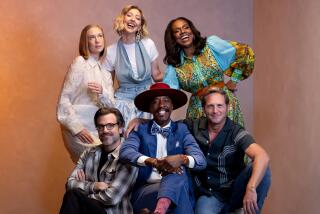Abracadabra! A New Attitude : A lesson brings an appreciation for the tricks and the trade. And there’s nothing up his sleeve--really.
- Share via
RESEDA — I never really believed in magic.
I could always spot the gimmick: the sleight of hand that made a card vanish. The trick sleeve that caused it to return. To me, magicians were just pre-Spielberg special effects men in bad tuxedos.
So, naturally, I didn’t trust Bob Raynor.
I came to the diminutive magician with the Beatle haircut to learn the tricks of his trade. It all seemed legit--his class was sponsored by the Cal State Northridge Continuing Education Program. And several other students attended the class at the Mid-Valley Athletic Club in Reseda. Yet as I shook Raynor’s hand, I couldn’t help but check his sleeve for double-sided tape, magnets or Velcro stitched into the fabric.
But I came back empty. It was just a firm handshake accompanied by a genuine grin.
Maybe there was more to this magic thing, I thought. So I settled back in my chair and listened.
My first surprise came early. Magicians use only 19 different magic effects, Raynor said. I had seen some of these: transposition (moving something from one place to another), vanishing (making something disappear), penetration (moving something through a solid object), anti-gravity (making something float) and invulnerability (being sawed in half).
Every trick, Raynor explained, uses one or more of these effects. And each trick has three components of its own.
*
“First, you must know the gimmick,” Raynor explained. “The sleight of hand. The trap door. Whatever. Then you must make it look natural. Finally, you must turn it into entertainment.”
To illustrate this, Raynor took out two plastic straws.
“We’re going to have a contest of strength,” he said.
As I watched, Raynor folded the two straws several times until they were wrapped around each other. He asked a student to pull two ends of the same straw while he pulled the other straw’s ends. It would be impossible for the straws to pass through each other, he said, so one must break. The stronger man would win.
The two men pulled. The student’s straw passed through, unbroken. Raynor opened his hand and his straw was . . . unbroken.
Then Raynor taught us how to do it. I was surprised at how easy it was.
“Knowing the secret is probably the easiest thing of all,” he added. “Making it work is the hard part.”
I practiced a couple of times with a fellow student until I had it down. The penetrating straw effect. It still didn’t feel like magic, but it did feel empowering. I was beginning to see why Raynor loved what he did.
My euphoria didn’t last long. Raynor pulled out a coin and taught us how to make it disappear, by cupping your hands or hiding the coin with your thumb. But I was all thumbs. I quickly gave up. After all, I already had credit card bills to make my money disappear.
But Raynor wouldn’t let my enthusiasm vanish. “Do you have to be proficient in everything to be a magician?” he asked. “No. You have to be proficient in something. As long as you are good at something, concentrate on that. My repertoire of tricks is only about 35.”
*
Those 35 tricks were enough to earn Raynor the 1991 national championship in close-up magic, the kind that’s done as a magician wanders from table to table in a club rather than in a show onstage.
He’s also carved out a living by performing his tricks at local restaurants, including Weber’s Place in Reseda, Don Ricardo’s restaurant in West Hills and the Magic Castle in Hollywood.
With renewed hope, I watched intently as Raynor pulled out his next weapon: the deck of cards. Fifteen minutes later, I had learned two new card tricks. At the end of the class, I even asked Raynor where I could get a book on magic tricks. And when I shook his hand, I didn’t even bother to look at his sleeve.
But the true test of magic came later at home. I decided to try the straw trick on my 5-year-old daughter, Solana.
I could still remember Raynor’s words: “Kids are the toughest audience in the world.”
Nervously, I pulled the plastic straws out of my pocket and began to fold, talking to my daughter of how strong she would have to be to pull the straws through each other. Then I gave her the two ends. And we both pulled.
Slowly, I looked into my daughter’s eyes.
And for the first time in my life, I saw magic.
(BEGIN TEXT OF INFOBOX / INFOGRAPHIC)
WHERE TO GO
What: “Close-Up Magic With Bob Raynor.” Raynor offers individual lessons any time by appointment. Or a six-week course can be taken through CSUN’s Continuing Education Program on Mondays, beginning Sept. 18.
Location: Individual lessons are arranged with Raynor. The CSUN program is offered at the Mid-Valley Athletic Club, 18420 Hart St., in Reseda.
Price: $35 per individual lesson, or $100 for four lessons with Raynor. The six-week CSUN course is $140.
Call: (818) 885-CSUN for CSUN course or Raynor at (818) 992-5139.


